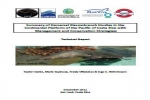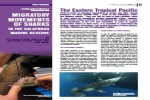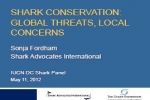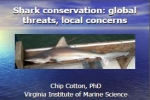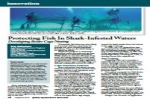Trophic inferences of blue shark in Mexico
Published online on 04. June 2012 Trophic inferences of blue shark (Prionace glauca) in the Mexican Pacific from stable isotope analysis in teeth Polo-Silva, C. J., Galván-Magaña, F. and Delgado-Huertas, A. ABSTRACT: RATIONALE Isotopic analysis of biogenic tissues such as teeth of elasmobranchs has been well recognized as an important method to interpret present and
Summary of Demersal Elasmobranch Studies in Costa Rica
Summary of Demersal Elasmobranch Studies in the Continental Platform of the Pacific of Costa Rica with Management and Conservation Strategies Tayler Clarke, Mario Espinoza, Fresia Villalobos & Ingo S. Wehrtmann Technical Report December 2011 PDF – DOWNLOAD
Pangnirtung Inuit and the Greenland Shark
Published online on 22. May 2012 Pangnirtung Inuit and the Greenland Shark: Co-producing Knowledge of a Little Discussed Species Carlos Julián Idrobo and Fikret Berkes ABSTRACT: When faced with a species that is seldom encountered or discussed, can local or indigenous people piece together their accumulated experience to make inferences about the ecology of that
Population genetics of Australian white sharks
Published online on 30. May 2012 Population genetics of Australian white sharks reveals fine-scale spatial structure, transoceanic dispersal events and low effective population sizes Dean C. Blower, John M. Pandolfi, Barry D. Bruce, Maria del C. Gomez-Cabrera and Jennifer R. Ovenden ABSTRACT: Despite international protection of white sharks Carcharodon carcharias, important conservation parameters such as
Assessment of shark sighting rates by aerial beach patrols
Published by the NSW Department of Primary Industries March 2012 Authors: William D. Robbins, Victor M. Peddemors and Steven J. Kennelly EXECUTIVE SUMMARY Aerial surveys are a recognised technique to identify the presence and abundance of marine animals. However, the capability of aerial observers to reliably sight coastal sharks has not been assessed, nor have
Migratory Movements of Sharks in Galapagos
Evaluating spatial effectiveness of existing marine zones Migratory Movements of Sharks in the Galapagos Marine Reserve By César Peñaherrera et al. ARGOS Forum # 74 ( 06/2012 ) See PDF-Page 10 – 11 PDF – DOWNLOAD
A new whipray species from the Persian Gulf
Published on 29. May 2012 Himantura randalli sp. nov., a new whipray (Myliobatoidea: Dasyatidae) from the Persian Gulf Peter R. Last, B. Mabel Manjaji-Matsumoto & Alec B. M. Moore ABSTRACT: A new whipray, Himantura randalli sp. nov., described from material collected off Bahrain, Kuwait and Qatar, appears to be endemic to the Persian Gulf. It
Regiospecific Analysis of Shark Liver Triacylglycerols
Published online on 24. May 2012 Regiospecific Analysis of Shark Liver Triacylglycerols Chamila Jayasinghe, Naohiro Gotoh und Shun Wada ABSTRACT: The liver oils of six shallow-water shark species, silky (Carcharhinus falciformis), thresher (Alopias superciliosus), oceanic whitetip (Carcharhinus longimanus), blue (Prionace glauca), hammerhead (Sphyrna lewini) and salmon (Lamna ditropis) were analyzed with particular attention to the
S. Fordham: Shark conservation – global threats, local concerns
PowerPoint Presentation by Sonja Fordham Shark Advocates International IUCN DC Shark Panel May 11, 2012 PDF – DOWNLOAD
C. Cotton: Shark conservation – global threats, local concerns
PowerPoint Presentation by Chip Cotton, PhD Virginia Institute of Marine Science PDF – DOWNLOAD
Feeding ecology of the deep-sea lanternshark Etmopterus pusillus
Forthcoming Publication Feeding ecology of the deep-sea lanternshark Etmopterus pusillus (Elasmobranchii: Etmopteridae) in the northeast Atlantic José C. Xavier, Cátia Vieira, Carlos Assis, Yves Cherel, Simeon Hill, Esmeralda Costa, Teresa C. Borges and Rui Coelho ABSTRACT: This study provides the first description of the feeding ecology of the smooth lanternshark Etmopterus pusillus based on stomach
Feasibility study on Coogee Beach Shark Exclusion Net
COOGEE BEACH SHARK EXCLUSION ZONE FEASIBILITY STUDY 1. Introduction: Over the last several years there has been an increased incidence of fatal shark attacks on swimmers, surfers and divers along Western Australia’s west coast, including the Perth Metropolitan area. Each of these attacks has been attributed to great white sharks. At the 10th November 2011
Age, growth and maturity of the brown stingray Dasyatis lata
Published online on 09. May 2012 Age, growth and maturity of the brown stingray (Dasyatis lata) around Oahu, Hawai’i J. J. Dale and K. N. Holland ABSTRACT: Baseline data on life-history characteristics of elasmobranchs are often lacking before fisheries exploitation, hindering successful management and conservation of affected species. Age, growth and maturity estimates were determined
Satellite Tracking of Manta Rays off Mexico’s Yucatan Peninsula
Published on 10. May 2012 Satellite Tracking of Manta Rays Highlights Challenges to Their Conservation Rachel T. Graham, Matthew J. Witt, Dan W. Castellanos, Francisco Remolina, Sara Maxwell, Brendan J. Godley, Lucy A. Hawkes ABSTRACT: We describe the real-time movements of the last of the marine mega-vertebrate taxa to be satellite tracked – the giant
Article: Protecting Fish In Shark-Infested Waters
Protecting Fish In Shark-Infested Waters Developing Better Cage Netting By Ken Robertson. Summary: Sharks are predators to warmwater aquaculture that are not stopped by traditional cage nets when they seek the fish contained inside. Work by the author with several international entities defined suitable lab testing methods that led to effective material selections and configurations


